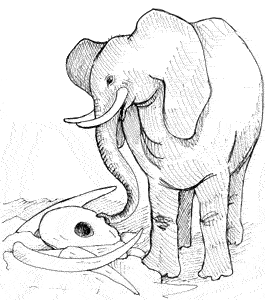STRANGE BUT TRUE- Grieving gnus: Animals feel sorrow too
 Q. Along with humans, which other species appear to "respect" their dead with special observances? –G.R. Malkin
Q. Along with humans, which other species appear to "respect" their dead with special observances? –G.R. Malkin
A. Few pay any interest, but chimpanzees show prolonged and complex behavior towards a dead social partner until the carcass starts to decompose, says New Scientist magazine, reporting on the work of Karen McComb. Elephants, it seems, never forget and may even pay "homage" to the bones of dead relatives. When McComb presented African elephants in Kenya with skulls from another elephant or a buffalo or rhinoceros, the pachyderms showed interest only in the skull of their own species, "smelling and touching it with their trunks and at times touching it lightly with their feet."
Presented with an elephant skull, a piece of ivory, and a piece of wood, the creatures showed strong preference for the ivory, then the skull. "The research team could not corroborate stories that elephants specifically visit the bones of dead relatives," the article says.
Killer whales and dolphin mothers will sometimes carry their dead young around for several days, pushing them to the surface, adds Lance Barrett-Lennard, senior marine mammal research scientist at the Vancouver Aquarium Marine Science Center & University of British Columbia. "Any human parent can relate... it's hard to watch."
Q. It's an ancient human question, one of the toughest ever: How can the material brain, which is an aggregate of nerves, tissues, and whatnot, be capable of subjective experience? Does modern science have an answer? –J. Jane
A. Perhaps in another century or two the "exactly how" of this may be adequately answered, though some believe it never will, says Harvard's J. Allan Hobson in 13 Dreams Freud Never Had. But the question can be turned on its head to ask how the brain would not be conscious when it has over 100 billion neurons, each connected to 10,000 others and firing at rates of 2-60 times every second. The information processed is more than 10^29 bits/second, or 100,000,000,000,000,000,000,000,000,000! "That's enough information to support both perception and the perception of perception, and enough to support awareness and awareness of awareness." In a word, it's enough to support consciousness, which emerges once the brain reaches a sufficiently high level of organization.
Q. When is swallowing a 3-inch metal bar that sits in the stomach collecting junk considered good medicine? –D. Flynn
A. When it's a cow "encouraged" to ingest a thumb-sized iron-alloy "cow magnet" placed in her second stomach (she has several) and that stays there attracting junk taken in with her food, says University of Minnesota veterinarian Ralph Farnsworth. Cattle don't chew their grass and hay well–preferring to chew their cud–so down the pipe go nails, fence staples, wire, other detritus of barnyard life.
Obviously, these can be "bad moos" a-roaming the digestive tract, causing "hardware disease"– arched back, grunting, etc. Rx: a $5 junk-anchor magnet that may last years before filling up, and is recyclable post-mortem.
Q. Where's the world's biggest collection of dead human brains, and of what use are they, anyway? –Igor
A. 8,000 pickled specimens reside–and have since the 1950s–in an underground World War II air-raid shelter beneath the Runwell Psychiatric Hospital in England, established to study causes of mental disease, says Clifford Pickover in Strange Brains and Genius. Scientists today examine them for clues to Alzheimer's, schizophrenia, even boxing injuries.
One study of brains of 15 former British boxing champions helped establish the link between the sport and specific brain damage, leading to better headgear for amateurs and reduction from 15 rounds to 12.
If you're a serious researcher, you can even have wafer-thin slices of relevant brains mailed to you– that's probably not you, Igor, however.
Q. What vitamin deficiency has played a bigger role in the history of the world than any other? –L. Pauling
A. Probably scurvy, or lack of dietary vitamin C (ascorbic acid), characterized by exhaustion and weakness, swelling of the arms and legs, loss of teeth, hemorrhaging from the nose and mouth, say Penny Le Couteur and Jay Burreson in Napoleon's Buttons: 17 Molecules That Changed History. Though the condition has been known about since ancient times, averting it with fresh fruits and vegetables on long sea voyages was another matter, with preventives and remedies often ignored or disbelieved.
For example, when the Portuguese explorer Vasco de Gama sailed around the tip of Africa in 1497, 100 of his 160-member crew died of scurvy. "Reports exist of the discovery of ships adrift at sea with entire crews dead from the disease." Some 90 percent of the crew of Magellan's 1519-1522 circumnavigation of the globe perished, largely due to scurvy.
Had the value of ascorbic acid been recognized earlier, the world today might be a different place, say Le Couteur and Burreson. With a healthy crew, Magellan might not have bothered to stop in the Philippines for as long, proceeding directly to the Spice Islands to corner the clove and nutmeg markets for Spain.
"Such a monopoly might have thwarted the establishment of the Dutch East India Company and changed modern-day Indonesia... The British, coming later to the South Pacific, would have been left with a much smaller empire and far less influence in the world, even to this day...." they write.
Send Strange questions to brothers Bill and Rich at , coauthors of "Can a Guy Get Pregnant? Scientific Answers to Everyday (and Not-So- Everyday Questions)," from Pi Press.
#